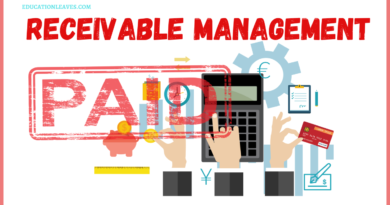What is Management, Management definition, the concept of management, levels of managers
What you are going to learn?
Concept of management :
- Management is an executive act that actively directs the human effort to a common goal.
- The main role of the management is to apply the knowledge and analytical approaches developed by numerous other disciplines.
- Management is the follower of the administration, it gets a salary or a part of the profit in lieu of its services.
- Management does not frame politics, it only implements the politics laid down by the administrator.
- Planning, organizing, staffing, motivation, directing coordination, and control are all the functions of the management.
- Management is considered as an art as well as a science.
What are the characteristics of management :
Here are some key characteristics of management that define its essence and nature:
- Goal-Oriented: At its core, management is driven by achieving specific objectives. Every organization, regardless of size or type, has goals it strives to reach. Management activities like planning, organizing, and controlling are all geared towards accomplishing these predetermined goals efficiently and effectively.
- Universal: The fundamental concepts of management are applicable across a wide spectrum of organizations, from small businesses to multinational corporations, non-profit entities, and even government agencies. While specific practices may vary depending on the context, the core principles of setting goals, organizing resources, and leading people to achieve those goals remain universally relevant.
- Continuous Process: Management is not a one-time event; it’s an ongoing cycle. The functions of planning, organizing, leading, and controlling are interrelated and constantly evolving. Managers revisit plans as circumstances change, adapt their organizational structures as needed, and continuously monitor and adjust their approaches based on ongoing results.
- Multidisciplinary: Effective management draws from various disciplines like economics, psychology, sociology, and even engineering. Managers need to understand human behavior, financial principles, market dynamics, and potentially even technical aspects of the organization’s operations to make informed decisions and lead their teams successfully.
- Dynamic: The internal and external environments organizations operate in are constantly changing. New technologies emerge, customer preferences evolve, and economic conditions fluctuate. Effective management needs to be adaptable and responsive to these changes. Managers need to continuously evaluate their strategies and be prepared to adjust course when necessary.
- Group Activity: Management is not a solitary pursuit. Managers work collaboratively with teams and individuals at various levels within the organization. Effective communication, delegation, and fostering a sense of teamwork are crucial aspects of successful management.
- Intangible Force: While the results of good management are evident in a well-functioning organization, the management process itself is often intangible. The leadership qualities, interpersonal skills, and problem-solving abilities of managers are difficult to quantify but have a significant impact on the organization’s success.
- Balance of Art and Science: Management is often referred to as both an art and a science. The science aspect lies in applying proven principles, methodologies, and data analysis to guide decision-making. The art comes in through a manager’s ability to inspire and motivate their team, effectively navigate complex situations, and make sound judgments based on experience and intuition.
Understanding these characteristics can help you appreciate the multifaceted nature of management and its crucial role in shaping the success of organizations.
Importance of management:
Management serves as the backbone of any organization, regardless of size, industry, or purpose. Its importance can be seen across various aspects that contribute to an organization’s success:
- Goal Achievement: Effective management establishes a clear roadmap for achieving organizational goals. Through planning, strategizing, and resource allocation, managers ensure everyone is working towards the same objectives. This focus and direction lead to a higher likelihood of accomplishing what the organization sets out to do.
- Efficiency and Productivity: Management practices like organizing tasks, streamlining processes, and optimizing resource utilization contribute significantly to efficiency and productivity. By minimizing waste and maximizing output, organizations can achieve more with less, leading to cost savings and a competitive edge.
- Employee Satisfaction and Motivation: Strong management fosters a positive work environment where employees feel valued, heard, and supported. Effective communication, delegation, and recognition programs create a sense of purpose and belonging, leading to higher employee satisfaction and motivation. This translates to increased engagement, lower turnover rates, and a more productive workforce.
- Customer Satisfaction: Management plays a crucial role in ensuring customer satisfaction. By focusing on quality control, streamlining operations, and providing excellent customer service, managers influence how customers perceive the organization. Satisfied customers are more likely to become loyal patrons and spread positive word-of-mouth recommendations.
- Adaptability and Innovation: The business landscape is constantly evolving. Effective management practices equip organizations to adapt to changing market trends, technological advancements, and unforeseen challenges. Managers who are responsive to change and foster a culture of innovation can lead their organizations to remain competitive and thrive in the long run.
- Social Responsibility: Management has a role to play in ensuring an organization acts responsibly towards society. Implementing sustainable practices, promoting ethical conduct, and giving back to the community are all considerations that fall under the purview of management. Responsible management practices not only enhance the organization’s reputation but also contribute positively to society as a whole.
Levels of managers or types of management
Organizations, especially larger ones, have a hierarchical structure with different levels of management. This hierarchy establishes a chain of command, clarifies roles and responsibilities, and ensures smooth operation. Here’s a breakdown of the three common levels of management:
Top Level Management (TLM):
- Focus: The big picture. TLM sets the overall direction and long-term goals for the organization. They are responsible for strategic planning, major decisions, and ensuring the organization’s sustainability and growth.
- Titles: Chief Executive Officer (CEO), President, Board of Directors, Chief Financial Officer (CFO).
- Responsibilities:
- Develop and implement organizational vision, mission, and strategic plans.
- Oversee financial performance and make major financial decisions.
- Ensure compliance with legal and regulatory requirements.
- Build and maintain relationships with key stakeholders (investors, partners, government).
- Appoint and oversee middle-level managers.
Middle Level Management (MLM):
- Focus: Translating TLM’s vision into actionable plans for their specific departments or functional areas. They bridge the gap between top-level strategy and day-to-day operations.
- Titles: Department heads (Marketing Director, Operations Manager, Human Resources Manager), Regional Managers, Division Managers.
- Responsibilities:
- Develop departmental goals aligned with the overall organizational strategy.
- Allocate resources and budgets within their departments.
- Develop and implement departmental policies and procedures.
- Motivate and supervise lower-level managers.
- Report progress to TLM and recommend course corrections as needed.
Lower Level Management (LLM):
- Focus: Direct supervision of frontline employees. They ensure daily tasks are completed efficiently and effectively, and provide coaching and support to their teams.
- Titles: Team Leaders, Supervisors, Foremen, Shift Leaders.
- Responsibilities:
- Assign tasks and schedules to employees.
- Monitor employee performance and provide feedback.
- Handle employee relations issues and grievances.
- Ensure adherence to safety protocols and quality standards.
- Report performance metrics to middle managers.
The Importance of Levels:
- Clear Chain of Command: Defines who reports to whom, preventing confusion and ensuring issues are addressed at the appropriate level.
- Specialized Expertise: Each level focuses on its specific area of competence, leading to more effective decision-making.
- Accountability: Clear roles and responsibilities make it easier to track progress and hold individuals accountable for their actions.
- Scalability: The hierarchical structure allows organizations to grow and add complexity while maintaining control.
What are the functions of management?
As I said earlier, management is the art of getting things done by others in formally organized groups. Managers manage the organization towards certain goals, in order to achieve that managers perform certain functions, these are called the functions of management.
Many management experts have given their own explanation regarding the functions of management but the concept is the same. Considering all the views of experts on management functions, it may be said that management involves the following functions-
- Planning,
- Organising,
- Staffing,
- Directing, and
- Controlling.
1. Planning:
In planning, managers decide what are the goals to be achieved, Where and How to achieve them planning helps to achieve the objectives easily and efficiently. Planning involves Forecasting before selecting the objective, making strategies and find out the best procedure to achieve them.
The planning function is mostly performed by the top-level managers but every level of managers will be involved in planning. The top-level manager spends their most of time in planning, the lower level managers follow the policies, programmes and procedures laid down by the top management.
While planning managers have to ensure the proper utilization of the resources (man, machine, material, money). This is the main goal of every organization.
Key elements:
-
- Goal setting: Establishing clear, measurable, achievable, relevant, and time-bound (SMART) goals that provide direction for the organization.
- Strategy formulation: Developing courses of action that define how the organization will allocate its resources to achieve its goals. This may involve conducting market research, analyzing competitor strategies, and identifying potential risks and opportunities.
- Action plan creation: Devising a roadmap that outlines the specific tasks, timelines, and resource allocation required to execute the chosen strategies.
2. Organising:
According to Henri Fayol, “to organise a business is to provide it with everything useful to its functioning — raw materials, tools, capital and personnel.” So, organising is the bringing together all the organizational resources and direct them systematically towards the desired goals.
Key elements:
-
- Organizational structuring: Defining the organization’s hierarchy, departments, and teams, ensuring clear reporting relationships and avoiding duplication of efforts.
- Resource allocation: Assigning human resources, financial resources, materials, and technology to various departments and projects based on their needs and priorities.
- Delegation: Assigning tasks and responsibilities to employees at appropriate levels, empowering them to take ownership and make decisions.
3. Staffing:
Every enterprise needs quality people for certain positions, especially for managerial positions. According to Management Theory by Harold Koontz and Cyril O’ Donell, “the managerial function of staffing involves manning the organisational structure through the proper and effective selection, appraisal and development of personnel to fill the roles designed into the structure.”
4. Directing:
Directing is the art of getting things done by the people, that means to tell subordinates, what to do and seeing that they do it with the best of their ability. Directing includes making assignments, corresponding procedures, seeing that mistakes are corrected; providing on-the-job instructions and, of course, issuing orders.
According to Unvick and Brech “directing is the guidance, the inspiration, the leadership of those men and women that constitutes the real core of responsibility of management.”
Key elements:
-
- Motivation: Encouraging employees to exert high levels of effort towards achieving goals. This can involve using various techniques like recognition programs, performance incentives, and creating a sense of purpose.
- Communication: Effectively conveying information, ideas, and expectations to employees. Leaders should be clear, concise, and transparent in their communication.
- Teamwork: Building a collaborative and supportive work environment where employees feel valued, respected, and empowered to contribute their best.
5. Controlling:
Controlling function is the process that effectively measures current performance and guides the work towards the pre-determined objectives. The essence of control lies in checking existing actions against some desired results determined in the planning process.
It determines what is being accomplished, evaluating the performance and finds if necessary applying corrective measures so that the performance takes place according to desired plans.
Key elements:
-
- Performance measurement: Setting standards and establishing metrics to track progress towards goals. This may involve using key performance indicators (KPIs) to measure various aspects of the organization’s performance.
- Evaluation: Analyzing the collected data to identify areas where performance meets or deviates from expectations.
- Corrective action: Taking steps to address any deviations from the plan. This may involve revising goals, adjusting strategies, or allocating additional resources.
People management skill :
To be a successful manager, you’ll need a blend of skills that encompass both technical expertise and interpersonal abilities. Here’s a breakdown of some key areas to focus on:
Technical Skills:
- Domain Knowledge: Having a solid understanding of the specific industry, field, or function you’ll be managing is essential. This allows you to make informed decisions, solve problems effectively, and guide your team in the right direction.
- Project Management: The ability to plan, organize, and execute projects efficiently is crucial for managers. This includes skills like budgeting, resource allocation, scheduling, risk management, and monitoring progress.
- Financial Literacy: Understanding financial statements, budgeting principles, and cost analysis is important for making sound financial decisions for your team or department.
Interpersonal Skills:
- Communication: Effective communication, both written and verbal, is paramount for a manager. You’ll need to clearly convey information, instructions, and expectations to your team, as well as actively listen to their concerns and feedback.
- Leadership: Inspiring, motivating, and guiding your team towards achieving goals are core leadership qualities. This involves fostering a positive work environment, building trust, and empowering team members to reach their full potential.
- Delegation: The ability to effectively delegate tasks is essential for managers who want to avoid burnout and empower their teams. This requires understanding individual strengths and weaknesses, assigning tasks appropriately, and providing clear guidance and support.
- Teamwork: Building strong relationships and fostering collaboration within your team is critical for success. This involves creating a sense of shared purpose, resolving conflicts constructively, and celebrating achievements together.
- Problem-Solving: Organizations inevitably face challenges. Strong problem-solving skills allow you to identify the root cause of issues, develop creative solutions, and make sound decisions under pressure.
Additional Skills:
- Time Management: Managing your time effectively is crucial for juggling multiple priorities and meeting deadlines. Techniques like prioritization, scheduling, and avoiding distractions can help you stay organized and productive.
- Decision-Making: Managers are constantly faced with decisions, both big and small. Effective decision-making involves gathering information, analyzing options, weighing risks and rewards, and choosing the course of action that best aligns with your goals.
- Emotional Intelligence: Understanding your own emotions and the emotions of others is vital for building strong relationships and navigating complex situations. This includes self-awareness, empathy, and the ability to manage conflict effectively.
- Adaptability: The business landscape is constantly evolving. Successful managers are adaptable and can adjust their strategies and approaches in response to changing circumstances.
- Continuous Learning: The world of management is constantly evolving. A commitment to continuous learning, through professional development programs, industry publications, or online courses, allows you to stay up-to-date with the latest trends and best practices.
Conclusion
In conclusion, management is the cornerstone of any well-functioning organization. It’s the art and science of organizing and coordinating resources (human, financial, material) to achieve organizational goals. Through a set of core functions – planning, organizing, leading, and controlling – managers establish a roadmap, structure the organization, motivate employees, and ensure progress stays on track.
Effective management practices are essential for achieving success in today’s dynamic business environment. By fostering a culture of goal-orientation, efficiency, employee satisfaction, and adaptability, management creates a foundation for organizations to thrive and make a positive impact.
Here are some key takeaways to remember about management:
- It’s a multifaceted discipline encompassing various functions and activities.
- Strong management skills are crucial for leaders at all levels within an organization.
- Effective management practices contribute to increased profitability, employee satisfaction, customer satisfaction, and organizational adaptability.
- There are different levels of management within organizations, with each level having specific roles and responsibilities.
- The core functions of management (planning, organizing, leading, and controlling) are interrelated and work together as a cycle.
Understanding the essence of management, its core functions, and the skills required to be a successful manager equips you to better navigate the complexities of organizations and contribute to their overall success.








Very helpful article thank you
Pingback: What is Decision making in management?, Types of Decision making, Importance of decision making. - EDUCATIONLEAVES
Pingback: 9 effective way how to measure productivity in the workplace|Eeducationleaves.com - EDUCATIONLEAVES
Pingback: MBO (Management by Objectives): pdf, Defination, Examples, Advantages, Disadvantages - EDUCATIONLEAVES
Pingback: What is Zero-Based Budgeting?|Advantages, Disadvantages - EDUCATIONLEAVES
Pingback: What is Management style? | 4 Basic Management styles and their Advantages and Disadvantages - EDUCATIONLEAVES
Pingback: Management Skills: 10 Important Managerial Skills | Types of Management Skills - EDUCATIONLEAVES
Pingback: Management is an art or science [ within 295 words], Is management is an Art or Science essay? - EDUCATIONLEAVES
Pingback: Travel And Tourism Management: Top Courses, Required Skills, Jobs and Careers, Salary Top 10 Indian and International Institutions and Companies - EDUCATIONLEAVES
Pingback: Leadership VS Management: A Comprehensive Discussion - EDUCATIONLEAVES
Pingback: Organizational Structure And Its Basic Types - EDUCATIONLEAVES
Pingback: Management Vs Administration | Differences Between Management And Administration - EDUCATIONLEAVES
Pingback: What is Break-even Analysis? |Break-even Chart - EDUCATIONLEAVES
Pingback: What is Production? , 4 types of production, Factors of production, production function - EDUCATIONLEAVES
Pingback: What is Product Planning? Elements of Product Planning, Advantages of Product Planning - EDUCATIONLEAVES
Pingback: What is Administration | Basics or Characteristics of Administration |Who is the Administrator? | Types of Administration - EDUCATIONLEAVES
Pingback: What is a Product Life Cycle? - EDUCATIONLEAVES
Pingback: Cost Control - Definition, Meaning, Differences between Cost control and Cost reduction - EDUCATIONLEAVES
Pingback: What is Standard Costing in accounting? Variance, Standard cost formula, advantages and dis-advantages - EDUCATIONLEAVES
Pingback: Importance of Communication - EDUCATIONLEAVES
Pingback: What is Materials management? Objectives, Functions of Materials Management, pdf - EDUCATIONLEAVES
Pingback: Procurement vs Purchasing: Difference between Procurement and purchasing - EDUCATIONLEAVES
Pingback: Management Process: Elements, Nature & Features - EDUCATIONLEAVES
Pingback: What is Procurement? Definition, Process - EDUCATIONLEAVES
Pingback: What is Supply Chain Management (SCM)? - EDUCATIONLEAVES
Pingback: What is Incremental Budgeting? Definition, Process, Advantages & Disadvantages (PDF inside) - EDUCATIONLEAVES
Pingback: What is Inventory management? - EDUCATIONLEAVES
Pingback: What is 5S methodology? - EDUCATIONLEAVES
Pingback: What is Forecasting? - EDUCATIONLEAVES
Pingback: What is Sales Forecasting? | Sales Forecasting Method, Types, Importance, and Elements | Sales Forecasting PDF - EDUCATIONLEAVES
Pingback: Strategic Management: Definition, Process, Types, Advantages, and Disadvantages | PDF Included - EDUCATIONLEAVES
Pingback: Crisis Management: Types of Crisis, Definition, Importance, Advantages Disadvantages, 6 Planning Approaches | PDF Included - EDUCATIONLEAVES
Pingback: Procurement vs Purchasing: Difference between Procurement and purchasing – US-GPA.COM
Pingback: Kanban- Definition, Process, Principles, Practices, Kanban Board, Advantages and Disadvantages [PDF Inside] - EDUCATIONLEAVES
Pingback: Emotional Intelligence: Definition, Skills, Testing, Benefits, Relation to management & Leadership [PDF Included] - EDUCATIONLEAVES
Pingback: Enterprise Resource Planning (ERP): [PDF Included] Types, Advantages, Disadvantages, Modules, Features - EDUCATIONLEAVES
Pingback: Knowledge Management: [PDF Inside]: Types, Process, Objectives, Purpose, 5 Key Practices, Application, Benefits, Drawbacks; Everything You Should Know - EDUCATIONLEAVES
Pingback: Operations Research: Evolution, Process, Characteristics, and Pros & Cons, [PDF Inside] - EDUCATIONLEAVES
Pingback: What is Relationship Management and how it works? Components, Stages, Types, Benefits, Purpose| PDF Inside - EDUCATIONLEAVES
Pingback: Customer Relationship Management (CRM) [PDF Inside]: Functions, Benefits, Limitations, and related Tips - EDUCATIONLEAVES
Pingback: What is Organization? Definition, Concept, Process, Types - EDUCATIONLEAVES
Pingback: What is System Analysis? |Key Concepts, Types, Steps - EDUCATIONLEAVES